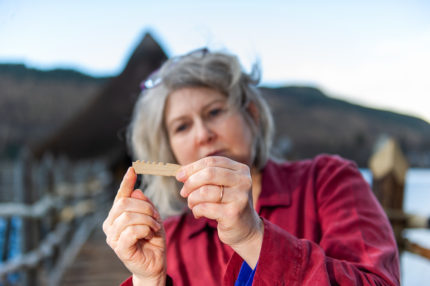It’s a small piece — a couple of inches of notched wood — but of great significance because it is believed to be a surviving fragment of one of the earliest musical instruments ever discovered in western Europe. It was found last week in the village of Fearnan on the north shore of Loch Tay in Perthshire, central Scotland. An underwater excavation of the banks discovered the object, thought to be the bridge of a plucked string instrument. It dates to around 500 B.C.
Crannogs were dwellings built above the water in lakes as early as 3000 B.C. Some of them were used for centuries, often continuously occupied, repaired and expanded upon until they formed elaborate artificial islands. The waterlogged environment can be a boon for the preservation of organic material
The Scottish Crannog Centre has received a grant from the National Lottery to investigate the bridge and its origins. Founded in 1997 and granted official accredited status by the Museums Galleries Scotland in late 2017, the Centre plans to use the instrument to launch a study of the role music played in Iron Age settlements in the area. A wood of the bridge has been crafted with 3D printing technology by Marco Gilardi of the University of the West of Scotland.
The Centre is a living museum that attracts 25,000 visitors a year, renown locally and abroad for its replica roundhouse built on stilts on the shallow lakeside just as they were in the Iron Age, and participate in period activities using accurate replica artifacts, including weaving, cooking, grinding grain and making fire. Rowing a replica longboat is one for the bucket list. As the museum’s mission is in exploring the daily life of Crannog communities, so having an artifact that exemplifies their music is a unique opportunity to study cultural aspects that rarely appear in the archaeological record.

Crannog’n Roll is here to stay! – But in all fairness: A “wood crafted with 3D printing”?!? :ohnoes: Had the woodcrafter been on holiday, or what?
Add a bit of stringing sheep intestines, a box and some pick-up and sound design, and off you go!
To give an example, here is what –with only 3 strings– ‘Ace of Spades‘ sounds like, when ‘neolithicked’ on a ..spade 🤠
Thanks so much for that great link. I am musically inept and therefore all the more fascinated by people who can make it spring forth from, well, garden tools. 😀
As for the 3D printing, it’s an increasingly popular technology in archaeology, especially for artifacts that will be touched, used, played with by researchers and aficionados alike, because the replicas are exact copies of the original in size and shape to the micrometer. Humans make more beautiful things, but that kind of precision belongs to the robotic races.
Here’s another blog post about music and history.
https://www.futilitycloset.com/2019/02/09/a-memorial-puzzle/
P.S. I have kayaked across Loch Tay. I must admit that I preferred sailing across it.
Well, that’s a great find, Hope sooner we will learn what sort of stringed device it was used in the pats.
😎